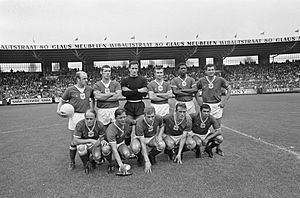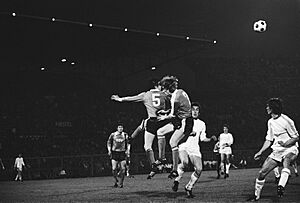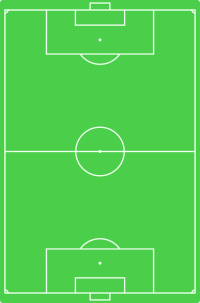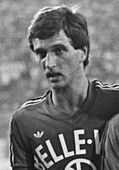History of R.S.C. Anderlecht facts for kids
The history of R.S.C. Anderlecht began on May 27, 1908. A group of football fans, led by Charles Roos, started the club called Sporting Club Anderlechtois. They met at the Concordia café in Anderlecht, a part of Brussels.
Contents
Starting Strong: The Early Years (1908–1935)
Charles Roos became the club's first chairman. SC Anderlechtois won their very first game with a score of 11–8 against Institut Saint-Georges. Their first playing field was near a cemetery in the Scheut area. Because they won many matches, the club decided to join official competitions in 1909. They started at the third level of provincial football. By the end of that season, they had already moved up to a higher division.
In 1911, Théo Verbeeck, a player, became the club's second chairman at just 23 years old. By 1913, Anderlecht reached the national level, joining the Promotion (the second tier of Belgian football). They finished fourth in the next season. Due to World War I, games stopped until 1919. As the team grew more popular, Anderlecht moved to a new stadium in Astrid Park in 1917. They named it Stade Emile Versé, honoring a big supporter, Emile Versé. In 1919–20, Anderlecht finished third, just missing out on the top league.
For the next season, Sylva Brébart became the club's first manager. Anderlecht finished third again, tied with FC Liégeois. This time, the Royal Belgian Football Association decided to promote two more clubs. So, FC Liégeois and SC Anderlechtois played a tie-breaker game. Anderlecht won 1–0 in a replay, thanks to a goal by Maurice Versé. Ferdinand Adams also helped a lot, scoring 30 goals that season.
Anderlecht's first season in the top league (1921–22) was tough. They finished 12th out of 14 teams. Striker Henri Thaels scored the club's first goal in the first division on September 4, 1921. In August 1922, Sylva Brébart was replaced by Charles Bunyan, Sr., a former manager of the Belgian national team. Sadly, he died ten days later, and his son, Cyrille Bunyan, took over. Anderlecht was relegated (moved down a division) in 1922–23. They won the second division the next year. But they were relegated four times in ten years (1923, 1926, 1928, and 1931). This led to rival clubs making fun of them.
Anderlecht reached their best league position yet in 1929–30, finishing fifth in the top division. In 1933, 25 years after forming, the club changed its name to Royal Sporting Club Anderlechtois. In the 1934–35 season, Anderlecht had a tough start. They changed managers and a committee took over. This worked well! Anderlecht won their part of the second division and were promoted back to the first division. They have stayed there ever since.
Winning Big: First Major Successes (1935–1968)
Anderlecht reached fifth place in the first division again in 1938–39. The championship stopped for two seasons because of World War II. When it started again in 1941–42, they finished sixth. After this season, Anderlecht signed a star striker, Jef Mermans, for a record fee in Belgium. With Mermans, nicknamed "The Bomber," scoring many goals, Anderlecht won their first league title in 1946–47. They had finished second in 1943–44 and third in 1945–46 (the 1945 championship was cancelled). Their success grew, and they won six more titles between 1948–49 and 1955–56. They even won three titles in a row, twice!
After the 1949–50 season, Bill Gormlie became manager. He stayed for nine seasons, the longest of any manager, and won five championship titles. In 1952, Anderlecht celebrated Théo Verbeeck's 40 years as chairman and the club's fourth title. The city even renamed the stadium street "Avenue Théo Verbeeck" in his honor. Sadly, he died a few weeks later. Albert Roosens, a former player, took over.
Their 1954–55 title allowed them to play in the first-ever European competition, the 1955–56 European Cup. Anderlecht lost both games against Vörös Lobogo from Hungary. However, they won the Belgian championship again that season. They played in the European Cup again the next year, losing to Manchester United. In 1958, for their 50th anniversary, Anderlecht invited Barcelona to play a friendly game, which ended in a 3–3 draw. Anderlecht then won the championship again in 1958–59.
The next season, Bill Gormlie left, and Pierre Sinibaldi became the new manager. A new era began with many talented young players joining between 1959 and 1961. These included goalkeeper Jean-Marie Trappeniers, defenders Laurent Verbiest, Jean Plaskie and Georges Heylens, midfielder Paul Van Himst and striker Wilfried Puis. In 1959–60, Anderlecht lost to Rangers of Scotland in their next European match. Anderlecht had to wait until the 1962–63 season to play in Europe again, after winning the 1961–62 title. They won their first European match 1–0 against Real Madrid after a 3–3 draw in Spain. They moved to the second round, beat CSKA Red Star of Bulgaria, but then lost to Dundee in the quarter-finals.
In the 1960s, under Pierre Sinibaldi, the club won five titles in a row (from 1963–64 to 1967–68). This is still a Belgian record! The 1964–65 title was their 11th, a Belgian record at the time. The team's biggest star in the 1960s was Paul Van Himst. He was the top scorer several times and won the Belgian Golden Shoe award multiple times. On September 30, 1964, the Belgian national team, coached by Raymond Goethals, played with 11 Anderlecht players against the Netherlands after a substitution. In the 1964–65 European Cup, Anderlecht won 1–0 at home but lost 2–1 away to Bologna. They played a replay game that ended 0–0, and Anderlecht won by a coin toss! In the next round, they were knocked out by Liverpool. The season after, they reached the quarter-finals again, losing to Real Madrid.
Since Sinibaldi arrived, the team played in a "Brazilian" 4–2–4 formation, different from older tactics. After three titles, Sinibaldi left in 1966. Hungarian Andreas Beres took over and coached the team to two more league championships. In those two seasons, Anderlecht lost in the second round of the European Cup to teams from Czechoslovakia.
European Glory (1968–1984)
Anderlecht reached their first European final in 1970 in the Inter-Cities Fairs Cup. This competition later became the UEFA Cup. A new rule helped Anderlecht advance: if teams were tied, the one with more "away goals" (goals scored in the opponent's stadium) would win. This helped them beat Dunfermline and Newcastle United. In the semifinals, they beat Inter Milan. In the final, Anderlecht won the home game against Arsenal 3–1. But they lost 3–0 at Highbury in the second game, so Arsenal won the cup.
In the summer of 1971, Constant Vanden Stock, a former Anderlecht player, became the new chairman. He brought in new players, including Dutch goalkeeper Jan Ruiter and forward Rob Rensenbrink. Anderlecht won their next domestic title at the end of the season, on the very last day! Another Brussels team, Racing White, drew with Club Brugge, which allowed Anderlecht to win the championship. They also won the Belgian Cup for the second time, achieving their second "double" (winning both the league and cup).
The next season, Club Brugge won the championship at Anderlecht's stadium, getting revenge after finishing second for five years. Anderlecht finished sixth, their worst result since 1952. This started a long rivalry between the two teams. Anderlecht still qualified for Europe by winning the Cup again, entering the European Cup Winners' Cup for the first time. That year, Anderlecht finished first again with a team led by Rensenbrink, Ludo Coeck, Paul Van Himst, and Attila Ladynski. Before the 1973–75 season, chairman Constant Vanden Stock decided to put the club's first shirt sponsor, his own brewery Belle-Vue, on the jerseys.
A period followed where the club won only one championship in ten seasons (between 1974–75 and 1983–84). However, they had huge success in Europe! They won two European Cup Winners' Cups, two European Super Cups, and one UEFA Cup. This started in 1974–75, when Anderlecht reached the quarter-finals of the European Cup, losing to Leeds United. In the league, they finished third. But they won the Cup 1–0 against Antwerp. This meant they could play in the Cup Winners' Cup again in 1975–76. They easily beat teams like Rapid București and Borac Banja Luka. The third round against Wrexham was harder, but they won. They then beat FSV Zwickau in the semifinals. In the final, they defeated West Ham United 4–2 at the Heysel Stadium in Brussels. This was their first European title ever! Rob Rensenbrink and François Van Der Elst each scored twice. Anderlecht also won the Belgian Cup against Lierse (4–0). Despite a great season, Dutch manager Hans Croon was replaced by Raymond Goethals.
Anderlecht played in the Cup Winners' Cup again and reached the final again. This time, they lost 2–0 to Hamburger SV of West Germany in Amsterdam.
Earlier that season, they played the 1976 European Super Cup. They won against the European Cup holder, Bayern Munich, a very strong team with stars like Franz Beckenbauer and Gerd Müller. Anderlecht lost the first game 2–1 but won the second game 4–1 at home. In Belgium, Anderlecht finished second in the league behind Club Brugge for the second year in a row. They also lost the Cup final to Club Brugge.
Anderlecht qualified for the 1977–78 European Cup Winners' Cup again. They got revenge by beating Hamburger SV, the team that beat them in the previous final. After that, they beat Porto and Twente to reach their third Cup Winners' Cup final in a row. The final was in Paris against Austria Wien. Anderlecht won 4–0, with two goals from Rob Rensenbrink and two from Gilbert Van Binst. Club Brugge won the Belgian championship again, with Anderlecht finishing second.
New players joined for the 1977–78 season, including Dutchmen Nico de Bree and Johnny Dusbaba, and Dane Benny Nielsen. Franky Vercauteren also became a regular player. At the start of the 1978–79 season, Anderlecht won the 1978 European Super Cup against Liverpool. They won the first game 3–1 at home, then lost 2–1 away. They also played in the Cup Winners' Cup as the defending champions but lost in the second round to Barcelona. This was a great season for Beveren, who won the Belgian league ahead of Anderlecht. Manager Raymond Goethals was replaced by Urbain Braems. Under him, Anderlecht lost early in the UEFA Cup and finished fifth in the Belgian league.
A new manager, Tomislav Ivić, was hired for the 1980–81 season. New players like defenders Morten Olsen and Luka Peruzović joined. Juan Lozano and Wim Hofkens also arrived during the winter break. Jacky Munaron became the goalkeeper. All these new players helped Anderlecht win their 17th championship title. In 1981, Anderlecht got a new shirt sponsor, the bank Général de Banque.
In 1981–82, Anderlecht lost the title to Standard Liège. But they had their best result in the European Cup, reaching the semi-finals. They beat Juventus and Red Star Belgrade. In the semi-finals, they lost to Aston Villa, who went on to win the cup. The 1982–83 season was special. Former Anderlecht star player Paul Van Himst became manager. The club won its third European title, and work began to rebuild the stadium. In the league, Anderlecht finished second behind Standard. Paul Van Himst took over as manager just before their UEFA Cup first round match in 1982. Anderlecht easily won (6–1). They then beat Porto and FK Sarajevo. Two wins over Valencia sent them to the semifinals, where they beat Bohemians Prague. For their first UEFA Cup final, Anderlecht beat Benfica 1–0 at home and 1–1 away, winning their fifth European trophy in seven years!
Two new Belgian players, Erwin Vandenbergh and Alex Czerniatynski, joined that season. In 1983–84, Anderlecht finished second in the championship, again behind Beveren. They also reached the UEFA Cup final. Their path to the final was tricky. In the semi-finals, they lost 2–0 to Nottingham Forest. They won the second game 3–0 at home. In the final, Tottenham Hotspur beat Anderlecht after a penalty shootout.
European Challenges (1984–2000)
After three second-place finishes in a row, Anderlecht easily won their 18th title in 1984–85, 11 points ahead of Club Brugge. The club scored 100 goals in 34 league matches that season! Alex Czerniatynski scored 22 goals and Erwin Vandenbergh scored 20. This was the first title under Paul Van Himst as coach. He was replaced by Arie Haan during the next season. In Haan's first European match, they beat Bayern Munich in the quarter-finals of the 1985–86 European Cup, reaching the semi-finals for the second time. They lost to Steaua București. After a play-off against Club Brugge, Anderlecht won the championship again, as both clubs finished with the same points. Erwin Vandenbergh was the top scorer with 27 goals.
The 1986–87 European Cup was a season of "revenge." Anderlecht beat defending champions Steaua București but then lost to Bayern Munich in the quarter-finals. Anderlecht won their 20th championship title on the last day of the season. They easily beat Berchem Sport, while rivals KV Mechelen lost. Franky Vercauteren and Enzo Scifo left the club that summer. A weaker team, coached by Raymond Goethals, finished fourth in 1987–88. But they won the Belgian Cup for the sixth time, beating Standard Liège 2–0. The next season, Anderlecht won the Cup again, beating Standard 2–0 once more. But they finished second in the league. They lost in the European Cup Winners' Cup to defending champions KV Mechelen. After his second cup win, Raymond Goethals left and Aad de Mos took over.
Anderlecht reached their last European final so far in the 1989–90 European Cup Winners' Cup. They beat Barcelona in the quarter-finals but lost the final 2–0 to Sampdoria after extra time. They also finished second in the championship. A talented group of players, including Luc Nilis, Marc Degryse, and Philippe Albert, helped Anderlecht have a great start to the 1990s. They won four league titles in five seasons (between 1990–91 and 1994–95) and one Cup title in 1993–94.
In 1993, RSC Anderlechtois joined with the women's team Brussels Dames '71 to become RSC Anderlecht. In Europe, Anderlecht reached the quarter-finals of the 1990–91 UEFA Cup, losing to Roma. The next season, Anderlecht played in the first European Cup to have a group stage. They reached the group stage but finished third. After the UEFA Champions League started, they reached the group stage twice. They finished fourth in their groups in 1993–94 and 1994–95. After winning three championships in a row, manager Johan Boskamp was replaced by Herbert Neumann.
The second half of the 1990s was harder for Anderlecht. Their next championship win was not until 1999–2000. In 1995–96, Anderlecht finished second in the league. They lost in the qualifying round of the 1995–96 Champions League. This was the first time Anderlecht lost their first European match since 1980–81. After losing the first game, new manager Herbert Neumann was fired after only four matches. Johan Boskamp returned as manager. At the end of the season, chairman Constant Vanden Stock retired, and his son Roger Vanden Stock took over.

In 1996–97, Anderlecht finished fourth in the league, their worst in nine seasons. But they were runners-up in the Belgian Cup, losing the final. They also reached the quarter-finals of the 1996–97 UEFA Cup, losing to Inter Milan. This is still the last time Anderlecht reached this stage in European competitions. At the end of the season, Johan Boskamp was replaced by René Vandereycken, who was soon fired. Arie Haan took over. With Haan, Anderlecht managed to qualify for the 1998–99 UEFA Cup by finishing fourth. After a bad start to the 1998–99 season, Arie Haan was fired. Jean Dockx and Franky Vercauteren took over. Anderlecht had an amazing comeback in the league, winning big games. They finished third. At the end of the season, Dockx and Vercauteren became assistants to Aimé Anthuenis. Under his coaching, Anderlecht won their 25th title in 1999–2000.
Modern Era: Recent Years (2000–Present)
In the 21st century, Anderlecht continued to be a top club in Belgium. They finished outside the top two only once (third in 2001–02). They won five titles between 2000–01 and 2009–10. In 2000–01, they had their most successful European season since 1996–97. Anderlecht beat Porto to reach the first group stage of the Champions League. They finished first in their group, even beating Manchester United. In the second group stage, they finished third. In the championship, Anderlecht finished first with their two strong forwards, Tomasz Radzinski (23 goals) and Jan Koller (22 goals). Both players were then sold to other clubs.
The next season, they reached the first group stage of the 2001–02 Champions League but finished last. In the league, Anderlecht finished third. Manager Anthuenis was replaced by Hugo Broos. With Broos, Anderlecht reached the round of 16 in the 2002–03 UEFA Cup, losing to Panathinaikos. They finished second in the league. The 2003–04 season saw Anderlecht in a very tough Champions League group with Bayern Munich, Lyon, and Celtic. They managed one win and one draw at home but finished fourth. In the 2004–05 and 2005–06 seasons, Anderlecht again reached the Champions League group stage easily. But they were in very tough groups both times. Anderlecht lost all matches in the group stage in 2004–05, setting a record for most consecutive defeats. However, in their last match of the 2005–06 group phase, Vincent Kompany scored a winning goal that ended their losing streak. In the Belgian league, Anderlecht won the championship twice, in 2003–04 and 2005–06. During the 2004–05 season, Hugo Broos was replaced by his assistant Franky Vercauteren.
Anderlecht then won the championship again, for the second time in a row with Vercauteren. But they struggled in Europe, finishing fourth in their 2006–07 Champions League group. They failed to win a single game, drawing four and losing two. During the 2007–08 season, Vercauteren was replaced by his assistant Ariel Jacobs. They lost in the Champions League qualifying round but then played in the UEFA Cup. They made it to the next round of the UEFA Cup. In the round of 16, Bayern Munich was too strong for them. Anderlecht won the Belgian Cup that year, their only trophy of the season, beating Gent 3–2. Former Gent players Mbark Boussoufa and Guillaume Gillet both scored in the final.
In 2008–09, they finished very close to champions Standard Liège. Both clubs had the same points, so a play-off was held. The first game was a 1–1 draw. Standard won the second game 1–0 to become champions. Romelu Lukaku made his first league appearance in this match. Anderlecht then won the next championship easily, losing only three games and finishing far ahead of Gent.
In the 2008–09 Champions League, Anderlecht failed to reach the third qualifying round. In the 2009–10 season, after winning against Sivasspor, Anderlecht lost both matches in the Champions League qualifying round to Lyon. In the 2009–10 UEFA Europa League, they won their group. In the round of 32, they beat Athletic Bilbao. However, they were knocked out in the round of 16 by Hamburger SV. In the 2010–11 season, Anderlecht was eliminated from the Champions League after a penalty shootout. In Belgium, the rivalry with Standard grew stronger. Anderlecht signed former Standard player Milan Jovanovic and brought back Dieumerci Mbokani. Ariël Jacobs' team became national champions for the 31st time that year.
RSC Anderlecht hired Dutch coach John van den Brom for the 2012-13 season. His first big success was reaching the group stage of the 2012-13 UEFA Champions League. RSC Anderlecht finished first in the Play-offs and became national champions for the 32nd time. Young players like Dennis Praet, Cheikhou Kouyaté, Guillaume Gillet, and Lucas Biglia were part of this winning team. The next season was harder for Van den Brom. The team finished last in its UEFA Champions League group. John van den Brom was replaced by his assistant Besnik Hasi. In the Play-offs, Anderlecht played almost perfectly and won the championship for the 33rd time. Chancel Mbemba, Aleksandar Mitrović, Massimo Bruno, and 16-year-old Youri Tielemans were new stars that season. The 2014-15 and 2015-16 seasons were not as successful.
In the 2016-17 season, a young Swiss coach, René Weiler, took over. Led by their own youth players Leander Dendoncker and Youri Tielemans, and top scorer Łukasz Teodorczyk, Anderlecht finished first in the regular league. In the 2016-17 UEFA Europa League, they reached the quarter-finals, losing closely to José Mourinho's Manchester United. A few weeks later, RSC Anderlecht celebrated its 34th national title.
On December 20, 2017, it was announced that businessman Marc Coucke would take over RSC Anderlecht. In 2019, Coucke made a big move by bringing in Vincent Kompany as a player-coach. But combining both roles didn't work out well, so Frank Vercauteren was hired as head coach. After another long-term injury, Kompany stopped playing in August 2020 and became Anderlecht's head coach after Vercauteren was let go. Before the 2022-23 football season, Anderlecht and Kompany agreed to part ways. Kompany moved to Burnley F.C. and Felice Mazzù replaced him. Many fans wondered why Kompany left, as he had led the team to third place and the Belgian Cup final the previous season. After four months, Mazzù was replaced by Danish coach Brian Riemer.
See also
- List of R.S.C. Anderlecht seasons







